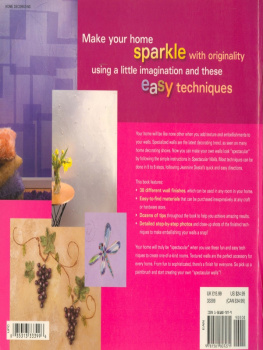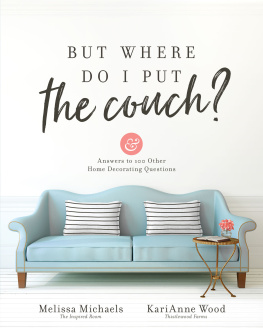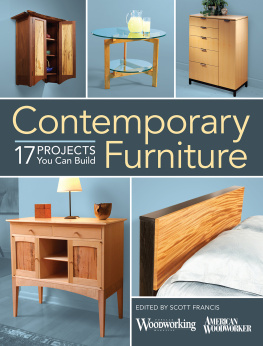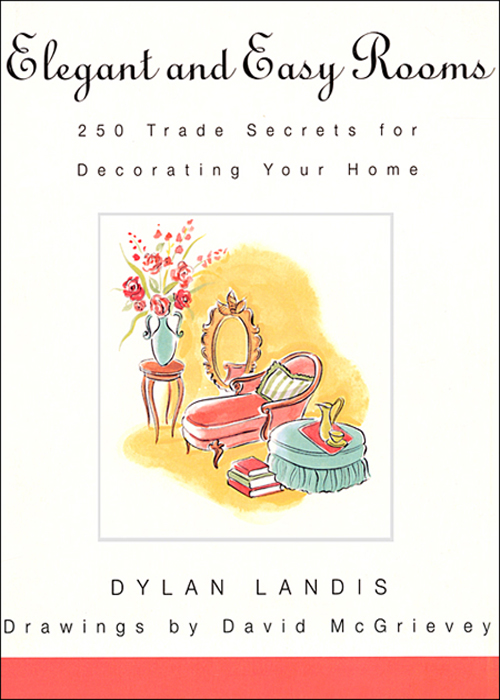
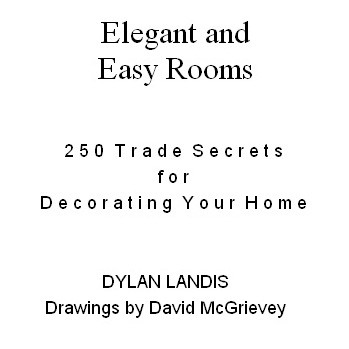
CONTENTS
For the wonderful women in the design writers group
HOW (AND WHY) TO USE THIS BOOK
Your home does not have to be perfect. Perfection is boring. It also costs too much.
This is a different kind of decorating bookabout a friendlier, more accessible way to design or simply upgrade the rooms you live in. It is a compendium of smart decorating and styling ideas, written for people who care deeply about their house or apartment but arent sure how to work the magic they admire in those gorgeous design magazines.
This is a book about how to pull rooms together in small ways and largewhatever suits your budget and your mood. Its about having a living room that invites you in again and again, a bedroom that works as a personal retreat, a dining room (or dining corner, if you live in a small space) that induces people to linger after dinner.
Its about achieving an overall look, if you choose to take it far enough, that can entice your friends to peer around corners and ask, Did you have help?
The truth is, most of us could use a little help. Most of us, faced with our own houses and apartments, arent even sure where to start. If all the furniture is roughly in place, how can you even tell whats missing, or what needs to get done first?
This book is full of starting placeshundreds of them, in bite-sized tips, techniques, and pointers. Every idea is workable, designer-tested, and able to harmonize with scores of other tips from other pages. All can move you toward the three ingredients of a terrific room: confidence,polish, and style.
Confidence is a rooms announcement that you knew exactly what you were doing (even if you didnt) when you put it together. Its the way pictures are assertively grouped rather than indecisively hung by themselves. Its the way furnishings relate to each other in spirit and scale (not in period perfection). A confident room probably has a high-quality, come-hither sofa because its owner knew where to invest, not just where to economize; and most important, you can tell right away what this person lovesrich pattern on pattern, perhaps, or a sanctuary of taupe and beige.
Yet it doesnt have to be perfect. A confident room is not so different from a stylish woman who puts together an economical wardrobe, investing in a few simple well-made basics and assembling the rest with flair, inventiveness, and a sure hand. In the end, you simply want your rooms to feel, as Min Hogg, the brilliant editor of Britains World of Interiors magazine, puts it, kind of right.
Polish is the sense that things are finished, and it usually comes down to details. In a polished room, the pillows have welting, the lampshades look custom made (even when theyre not), and the doors are dressed in good hardware. Polish means that the reading light shines where you need it but doesnt glare, and that theres always a convenient spot to put down a drink.
If you collect thingsbooks, vintage blue glass, photographs of old rosespolish means you have a place for everything, however artlessly casual it may appear.
Style is what makes the place yours. Its what gives you the nerve to paint the dining room teal or red. Its the way you mass twenty candlesticks on a mantel instead of the usual pair; or have a dinner-plate-sized monogram embroidered on a living-room pillow.
Style, like polish, can also come down to details. Style is having the nerve to place your love seat at an angle, knowing it will open up the room; its having the imagination to sew chandelier crystals to your curtains so they catch the sun; its having the flair to gang mirrors, or even empty antique frames, as if they were pictures on the wall.
Every design idea in this book has been distilled to a single tip or decorating recipe. One may hold the perfect yellow for your living room walls. A second will explain an excellent spot in any room for built-in bookshelves. A third will suggest a way to dress your windows for less, and a fourth will show how to make a tiny bedroom feel (and function) like a larger one.
You wont feel drawn to every idea, because everybody has different taste. But all of these tips have been used at some time, in someones home, successfully. Some are classic. A few are admittedly quirky. All of them have worked.
Choose any handful of ideas from these pages that appeals to your sense of comfort, your eye for design, your budget, and your home. They will work togetherbecause your taste, and your personality, will bring the same spirit to bear on every decorating decision you make.
WHAT IF I DONT REALLY TRUST MY OWN TASTE?
Then spend a little time learning what you love and what you dont. It will help your rooms look more harmonious and increase your confidence.
Theres actually a technique for this, one that many interior designers recommend to their clients:
Start keeping two files, one labeled What I Love, the other What I Hate. Amass a stack of good design magazines, and tear out pictures that move you strongly, one way or the other. Use Post-its to note the particular detailsa curtain, perhaps, or the color of a wallthat you feel either make or break a room.
When the files are full, examine each for what its pictures have in common. Is one file stocked with traditional furnishings, the other with contemporary built-ins? Are you repeatedly drawn to rich colors, or do you prefer the serenity of neutral tones? Are there five examples of regally striped wallpaper in the Love file?
Observations like this will give you a sense of personal direction. For precisely this reason, many high-priced designers and architects will begin a project by poring over the clients picture files.
WHAT WILL IT COST, AND WHAT SHOULD I SPEND?
This depends on your budget, and your priorities. Some of the decorating recipes in this book require only time and labor, like gathering pictures into a handsome constellation on the wall. For $20 you might buy a pair of ready-made glass-and-clip frames to update a pair of botanical prints. For $100 you can buy a halogen torchre that will beautifully light up a dim room. For $200 you might find a battered four-poster bed at a tag sale, then spruce it up with $30 worth of sandpaper and paint. For $1,000 you can pay a New York City building superintendent to paint a two-bedroom apartment. It depends on what you want, what you can afford, and how creatively you can bridge the gap between them.
In my opinionand you must form your ownany improvement that makes a major difference in your daily experience of home and that costs less than $2,000 can probably be considered an excellent value. But you can make elegant upgrades for one-tenth that amount, and less.
Two other factors to consider:
When do you need the best? A 1930s chair can be recovered in plush new mohairjust like the original upholsteryat $110 a yard, or in velvet (at discount) at $20 a yard. Ask yourself how youll feel in three or five years: Would you rather have bought the mohair at any price? Or will you be glad you bought the velvet and saved?
Renters should not spend big money on things they must leave behind. Spend $1,000 on a vintage rug, not on refinishing the floor. Dont have shelving built in when you can buy antique bookshelves and take them with you. This may seem obvious, but in years of renting I could never resist building in that shelving or refinishing floors. For me, it was a compulsion. If you can save the money, do.
Next page



